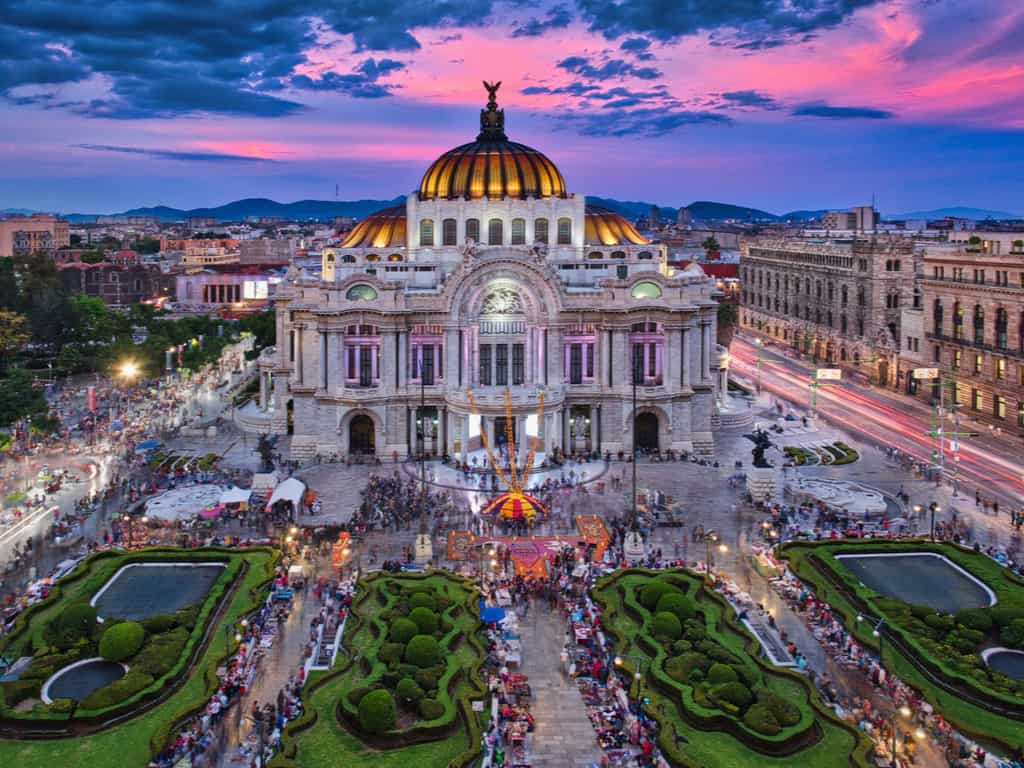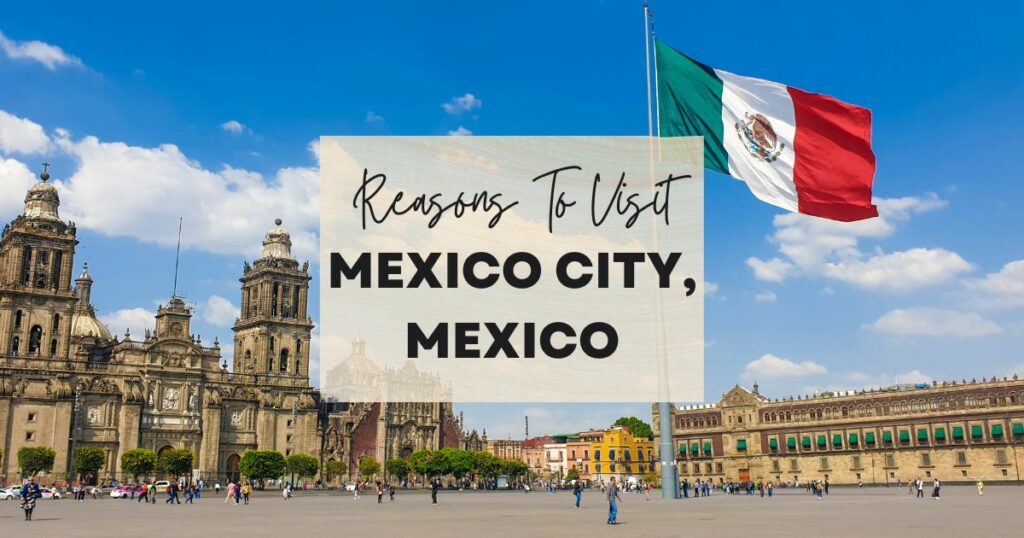Deciding to travel to Mexico City, Mexico? Check out the list of the best things to do in Mexico City, Mexico, and places to go in Mexico City, Mexico, below. We at Wondrous Drifter, a Web 3.0 travel startup, have big plans to shake things up in the travel business.
Table Of Content
- Casa de Los Azueljos
- Cineteca Nacional
- Chapultepec Park
- Churreria El Moro
- Frida Kahlo Museum
- La Ciudadela
- La Lagunilla
- Mercado Coyoacan
- Mercado Roma
- Metropolitan Cathedral
- Mezcal Tastings
- Museo Nacional de Antropología
- Museo Jumex
- Museo Soumaya
- Museo Universitario Arte Contemporaneo
- Palacio de Bellas Artes
- Palacio National
- Street Food Tours
- Templo Mayor
- Teotihuacan
- Trotsky Museum
- Xochimilco
- Zocalo
Casa de Los Azueljos

The House of Tiles is a permanent monument to Mexican art and culture.
The building has a blue, white, and yellow tile front, a mural by renowned Mexican painter José Clemente Orozco on the interior, and a glass-ceilinged atrium with stone pillars, paintings, and a fountain.
These ornately adorned walls have seen a microcosm of Mexican history, having housed noblemen and labor unions before becoming the most magnificent branch of a chain restaurant.
The Counts of the Valley of Orizaba and their families lived in the structure from the 17th to the 19th centuries. Several legends surround its famed tiles, which first appeared around 1735.
According to one theory, the tiling resulted from a fight between a father and his son, who had been partying too much.
When the young man’s father told him he was useless, he fixed up his act, built his fortune, and covered his family’s house in tiles to show his dad that he could at least build beautiful structures.
Visitors may take a selfie outside the tiled facade or dine at Sanborns’ full-service restaurant.
Sanborns’ extensive menu features steak, hamburgers, and Mexican specialties like pozoles, tacos, and molletes, all of which are adorned with the same peacocks that adorn the atrium’s ornate walls.
Visit this beautifully tiled building like no other.
Address: Av. Madero 4, Centro Historico, Mexico City, 06500 Mexico
Cineteca Nacional
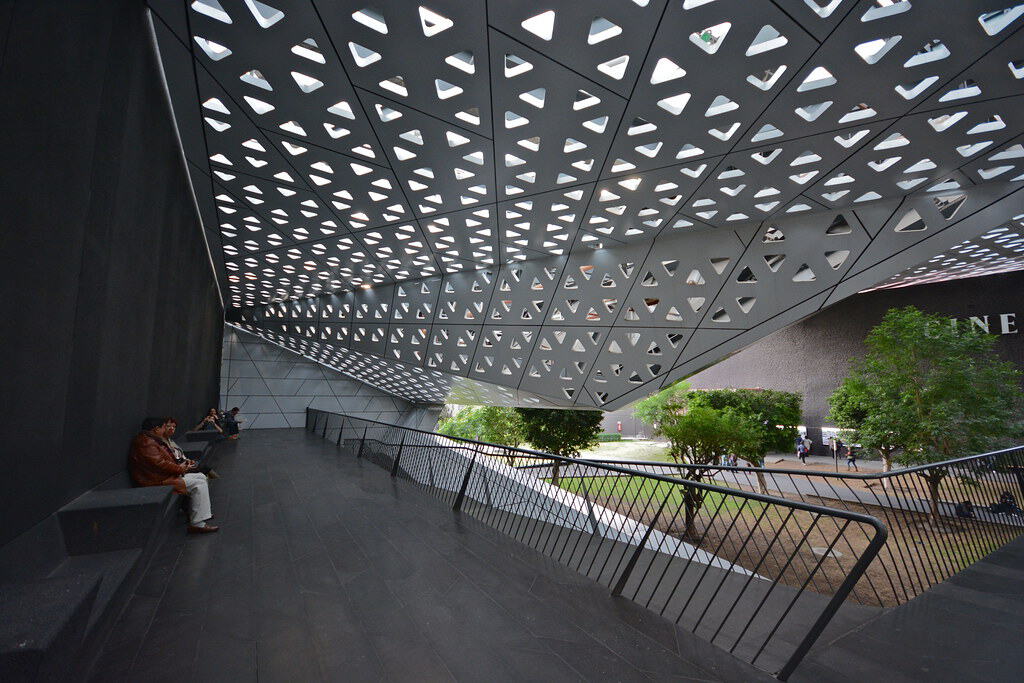
Its halls are brimming with cinematic gems.
An archive that safeguards and preserves Mexico’s most valuable film collection is a highlight.
This collection was developed due to an unusual legal deposit rule that required a production company to submit a copy of its film to the institution if it wished to shoot it in Mexico.
The National Cineteca of Mexico has a long history of film preservation. It first opened in 1971, but after a fire in 1982, it relocated to a new and upgraded location, which it still occupies today.
The current Cineteca concentrates on indie films. However, it does show certain blockbusters.
There’s more here than you’d expect from a typical movie theater. One of the theaters is on the grounds, making for a wonderful outdoor experience.
Individuals or small groups can rent a private room to view a vintage film from the space’s unique video archive.
The Plaza del Cubo is the most iconic location, named after a sculpture that had stood there since before the Cineteca was erected.
Collectors will find coffee cafes, bars, and boutiques specializing in cinematographic products. As if that weren’t enough, the area includes a museum and a series of galleries with continually changing exhibits.
What are you waiting for? Visit the Cineteca Nacional now and see an incredible archive of movies.
Address: 389 Av. México Coyoacán, Mexico City, 03330 Mexico
Chapultepec Park
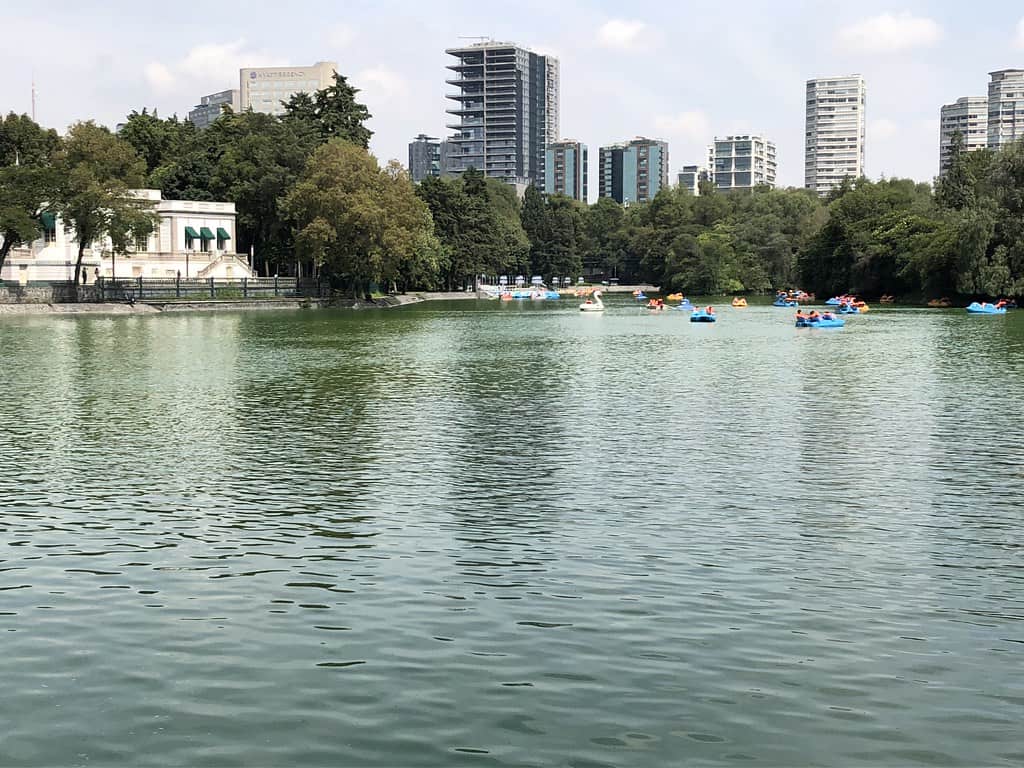
A park that rivals the likes of Central Park.
If you thought Central Park in New York was great, wait till you visit Chapultepec Park, or the Bosques de Chapultepec, in Mexico City.
The trees of the Chapultepec forest have been referred to as the city’s lungs since ancient Aztec times when the park functioned as a royal retreat.
Walking, running, bike routes, the Chapultepec Zoo, and numerous prominent Mexico City institutions, such as the Museum of Anthropology and the Rufino Tamayo Museum, are inside the park.
You can also visit the Chapultepec Castle, which is included separately on this list of things to do in Mexico City. Local families, vendors, and performers crowd the park on weekends.
Simply avoid visiting on Mondays when the park is closed.
The park is known for its biodiversity, lush gardens, and being home to some of Mexico City’s most famous attractions.
It’s no wonder it was named one of the most beautiful parks in the world by the World Urban Parks Association.
Stroll around the stunning Chapultepec Park now.
Address: Miguel Hidalgo, Mexico City, Mexico
Churreria El Moro
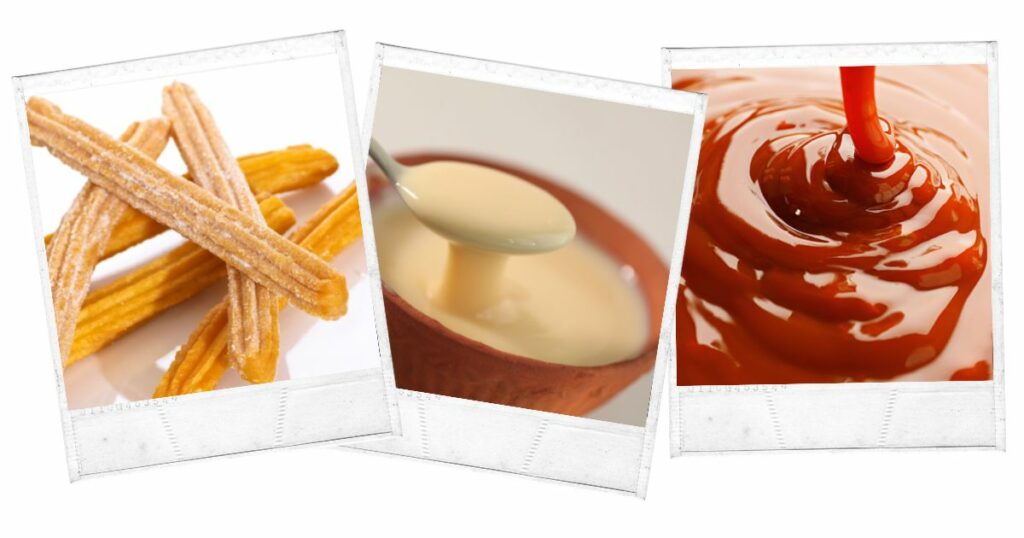
It’s always a good time for churros.
When you first walk inside Churros el Moro, you’ll notice that the churros are freshly baked behind the counter.
Take a look at how the churros are made. A churro uses tongs to lift the dough and then slices it into straw-length tubes. The churros are then rolled in sugar, either ordinary or cinnamon. Finally, they’re served hot with your choice of dip: chocolate, caramel, or condensed milk.
The menu is simple: churros, chocolates, and a few more beverages and snacks are available. A churros order costs 24 Mexican Pesos, or just over USD 1. Alternatively, indulge in some churros and chocolate for 77 Mexican Pesos ($4).
Francisco Iriarte of Spain developed Churros el Moro in 1935 after noticing that churros were not offered in Mexico City. He chose to set up a churros cart in the Zocalo, the main square in Mexico City’s Historical Center, in 1933.
By 1935, he had opened the first formal churros business, kicking off Mexico’s churros history.
Have some of these yummy delights now when you visit Mexico City.
Address: Churreria El Moro, Mexico City, Mexico
Frida Kahlo Museum
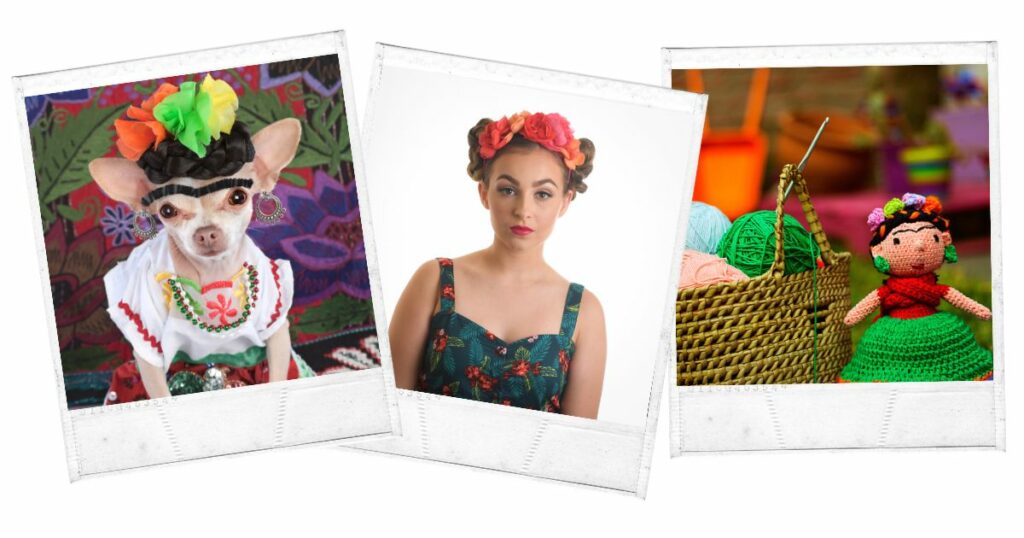
Pay homage to one of the world’s most famous women.
The outside of La Casa Azul is a basic structure in the Coyoacan district that might be ignored if it weren’t for its startling blue color.
But beyond the sky-colored concrete is a realm where two of Mexico’s most celebrated artists met Marxist revolutionary Leon Trotsky.
La Casa Azul, the childhood home of Frida Kahlo, was already a hub of intellectual activity when Trotsky arrived in Mexico City.
She learned to paint in La Casa Azul, where she was bedridden following a bus accident, leaving her in excruciating pain for the remainder of her life.
La Casa Azul began to take shape as her painting began to gain traction.
The museum allows visitors an intimate view within the walls, some of which were renovated by Rivera, who studded them with volcanic rock and ceramics.
Kahlo died in the home in 1958, and her husband gave it to be made into a museum dedicated to her life and works.
Moreover, the museum includes a look at the husband and wife’s history and a pre-Columbian courtyard pyramid with some Aztec and Toltec antiquities.
It also has a renowned inscription left behind by the turbulent pair.
Pay a visit to Frida Khalo’s home now and see a place that has inspired some of her most famous works.
Address: 247 Londres, Londres y Allende, Mexico City, 04100 Mexico
La Ciudadela
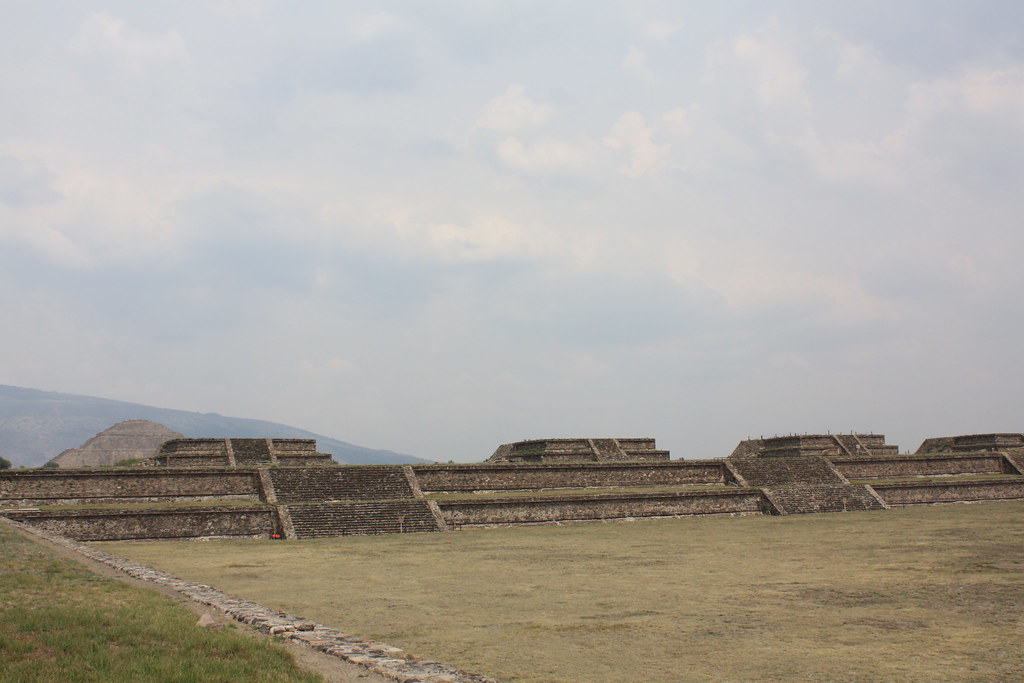
Every step you take in this almost 50-year-old artisanal market reveals a rainbow of hues.
Check out the market at the Mercado de Artesanas La Ciudadela, adjacent to the historic center, whether you’re seeking local souvenirs, folk art, or just a colorful gift to take home from Mexico.
The initial purpose of La Ciudadela was to display arts and crafts from all around the country during the 1968 Olympics. Few locations and specialties remain unrepresented among its congested, jammed, and bright aisles.
Explore the shelves of jugs, skulls, and jaguar heads made of wood, black mud, or Huichol design, traditional games, palm-leaf baskets, and Talavera plates.
Don’t miss out on the alebrijes, which is an Oaxacan-Mexican folk art sculpture of magical creatures and copies of pre-Hispanic items of art.
Many market vendors accept credit cards. However, you may be able to barter costs down if you pay in cash pesos.
This market has all of the artesania that can be found at the country’s tourist attractions.
Don’t forget to stop by La Ciudadela on your next trip to Mexico City.
Address: Balderas S/N, Colonia Centro, Centro, Cuauhtémoc, 06040 Cuauhtémoc, CDMX, Mexico
La Lagunilla
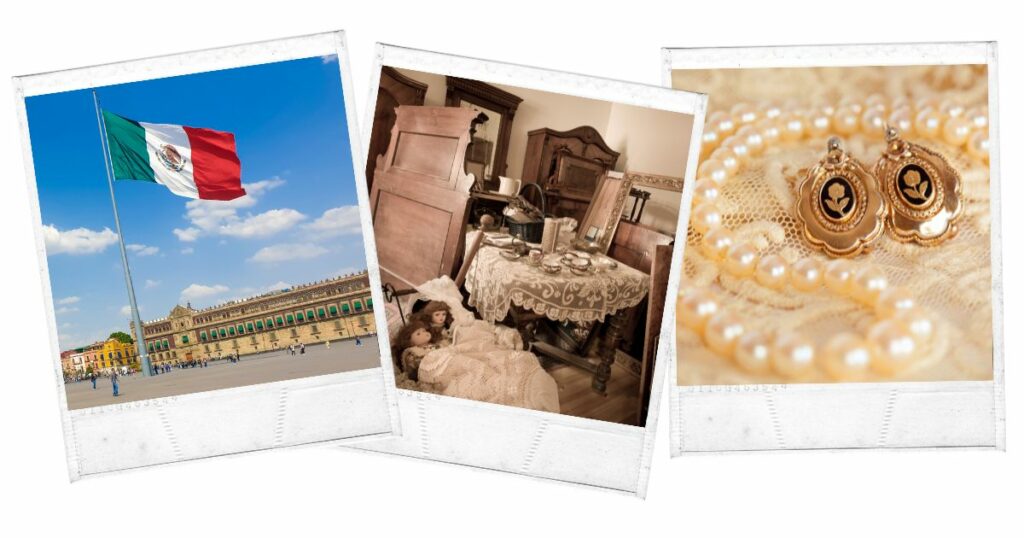
A massive, Sunday-day-only bazaar with anything and everything.
La Lagunilla is one of Mexico City’s most famous open-air markets.
Hundreds of vendors arrive at 6 a.m. every Sunday to set up their stalls in the streets of Morelos, a neighborhood close to Tepito.
From 1970s record players to analog cameras, artworks from the turn of the century, and games that will help restore childhood memories, you will find a wide range of products, clothing, and vintage furniture here.
The Sunday market dates back to pre-Hispanic times when people would gather at a local tianguis to sell and trade.
As a result, it focuses on antiques, including mid-century modern furniture, records, vintage clothing, and jewelry.
Even though negotiation is expected, dealers understand the value of what they have. Therefore an authentic Saarinen end table will not be cheap.
You can always bring back smaller trinkets if suitcase space is a concern.
Wander around this market with a michelada in hand and have an amazing time now.
Address: La Lagunilla, Mexico City, Mexico
Mercado Coyoacan
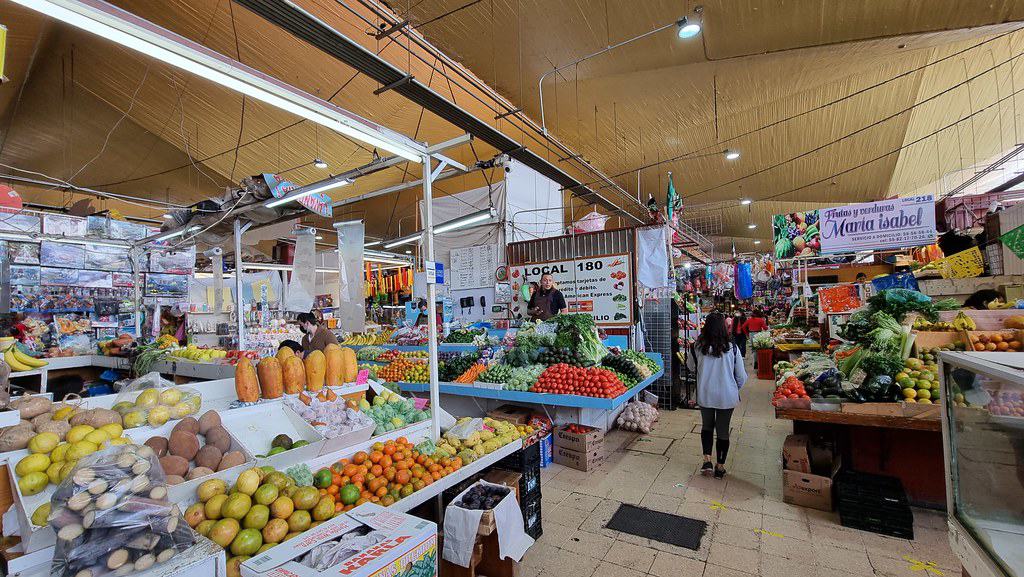
This market shows Mexican authenticity. It is a glimpse into daily life in the area.
Coyoacán, which means “place of coyotes” in Náhuatl, is renowned as Mexico City’s historic-artistic core, thanks in part to the impact of Frida Kahlo and Diego Rivera.
The lingering impact can be seen at Coyoacán Market, just a few blocks from the Frida Kahlo Museum.
The Coyoacan Market, which opened in 1921 but has since moved, has been selling everything from vegetables to baskets throughout the greater part of the twentieth century.
One of Mexico City’s most well-known markets.
The food, however, is the major lure of Mercado Coyoacán.
Everything can be a little more expensive due to the large tourist attraction.
Still, seafood and barbacoa, in particular, are worth their weight in pesos.
This market is fantastic for anyone who wants a truly local experience, whether you want to ogle at all the fruits and vegetables or snag some bargain textiles.
The shopping alleyways are narrow, so stay away if you’re not a lover of crowded, cramped settings.
See the everyday lives of locals, eat amazing food and shop for the best souvenirs here at Mercado Coyoacan.
Address: Ignacio Allende s/n, Del Carmen, Coyoacán, 04100 Ciudad de México, CDMX, Mexico
Mercado Roma
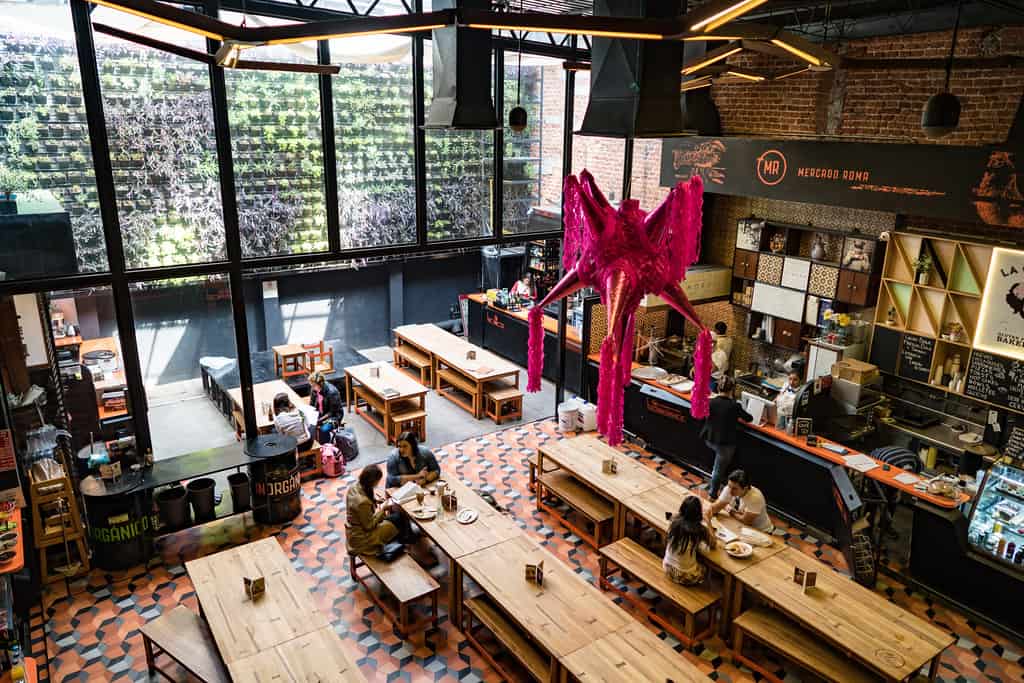
Eat your heart out at the city’s first gourmet market.
Before it was developed, neighbors protested the Mercado Roma, arguing that gentrification would destroy the region.
The three-story mixed-use market is ideal for sipping Spanish wines and eating tapas, shopping for costly cheeses, and nibbling snacks from the numerous puestos (stalls).
Mexico City’s first gourmet market, Mercado Roma, is located in the bohemian, gradually gentrifying Roma quarter.
The market is a multi-story facility dedicated to expressing and exploring Mexico’s rich culinary traditions, with a variety of gastronomic tenants offering high-quality delicacies and products.
In fact, it is collaborative and open, drawing on the custom of dining around a communal table.
Seating isn’t restricted to a single vendor. Still, it flows across the floor, allowing communal dining experiences as customers enjoy barbeque, sushi, pastries, and other treats.
Contemporary interpretations of Meso-American patterns, textures, and designs enhance the experience, giving it a familiar but forward-looking sense.
There are so many culinary options to choose from so take your pick at the Mercado Roma now.
Address: C. Querétaro 225, Roma Nte., Cuauhtémoc, 06700 Ciudad de México, CDMX, Mexico
Metropolitan Cathedral
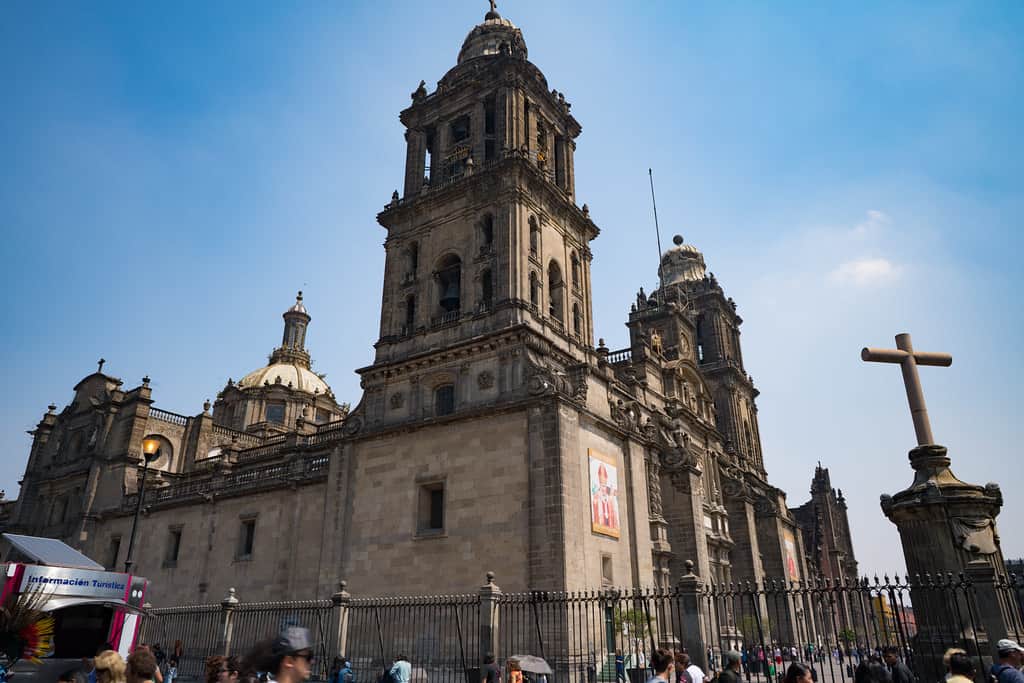
Visit this historic icon of Mexico City.
The Metropolitan Cathedral is, without a doubt, one of Mexico City’s most important historical structures.
You will learn about Mexican architecture and art from five centuries of history, as well as its spiritual significance in Mexico.
The colonial Spaniards built the most spectacular church in the Americas on the ruins of an Aztec temple in the heart of the Aztec metropolis of Tenochtitlan.
Its massive size, intriguing history, and stunning art and architecture make it one of the country’s most notable structures.
Moreover, the Archdiocese of Mexico is housed at the cathedral, which is built on the northern side of Mexico City’s main plaza, recognized as the Zocalo.
Next to the Templo Mayor archaeological location, which offers a glimpse into life in the 1500s, way before Spaniards came.
Check out the Metropolitan Cathedral on your next visit to Mexico City.
Address: P.za de la Constitución S/N, Centro Histórico de la Cdad. de México, Centro, Cuauhtémoc, 06000 Ciudad de México, CDMX, Mexico
The only thing that you can buy that will actually make you richer is travel. The places you visit leave an indelible mark on your identity. Go travel, trust us, it’s worth it. For the full list of countries to visit around the world, visit our how travel the world guide. When traveling the world, you can’t skip the United States. America is one of the easiest countries in the world to get to. Click here for the beautiful states to visit in USA.
Mezcal Tastings
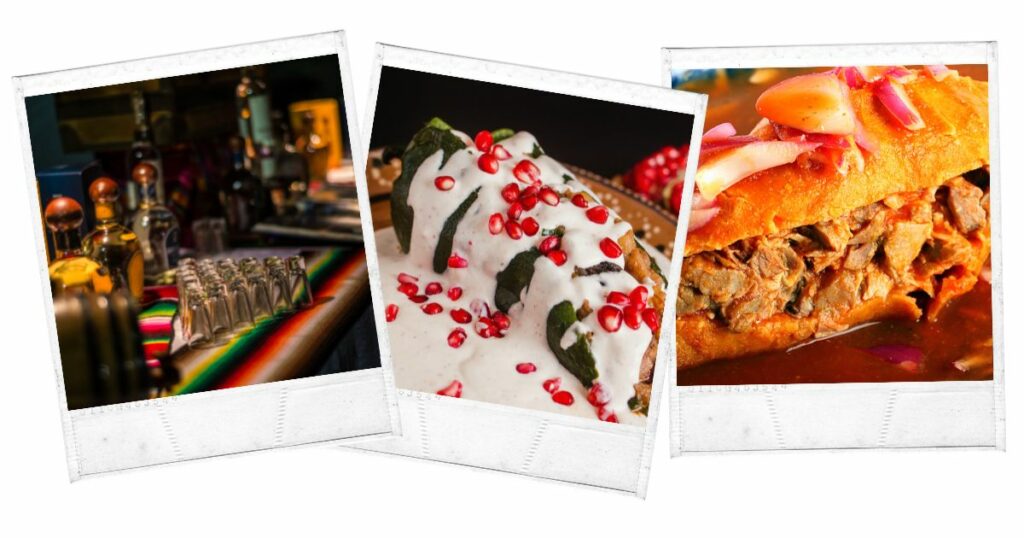
Once again, folks, it’s drink o’clock!
You’ve arrived at mezcal’s home, a potent alcoholic beverage made from agave plants.
Mezcal is tequila’s stronger, smokier sibling, and sipping it is a must-do in Mexico City.
Even though the alcohol is primarily produced in Oaxaca, Mexico City is a great spot to sample some of the best big-name and small-batch brands.
Food & Mezcal Tours If you’re apprehensive about trying mezcal on an empty stomach, consider a combination tour that includes a bite of traditional Mexican cuisine.
Spend an evening eating tacos or sampling other popular street delicacies in the capital, such as tortas, tamales, or chicharrónes.
If you choose, combine mezcal tastings with a culinary class or a tailored full-day tour of Mexico City’s most prominent attractions.
Nightlife & Mezcal Tours The Mexican city, especially after hours, may be overwhelming.
So, rather than braving it alone, join an experienced guide on a small-group tour of some of Mexico City’s greatest bars for mezcal tastings and more.
What are you waiting for? Come to Mexico City and sample some Mezcal now!
Address: Mexico City, Mexico
Museo Nacional de Antropología
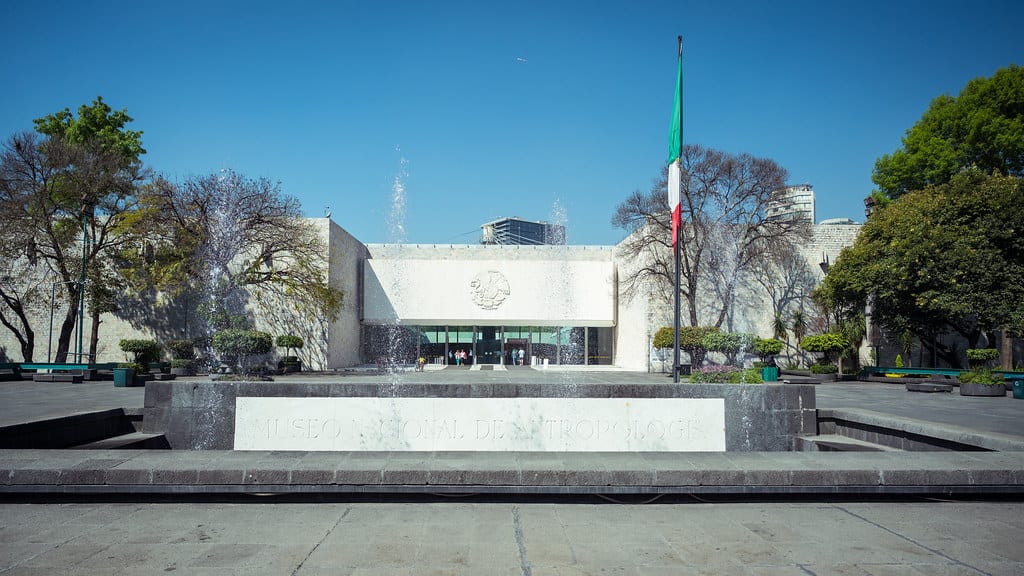
Check out this floating architectural wonder.
The National Anthropology Museum in Mexico City is the place to go if you want to see the world’s greatest collection of Mesoamerican artifacts.
The Chapultepec Park is one of the city’s most well-known museums, maybe second only to the Museo Frida Kahlo.
In regardless of the way that it was built in 1964 by the legendary Mexican architect Pedro Ramrez Vázquez, the vast edifice nevertheless looks to be cutting-edge today.
Moreover, the museum houses the largest exhibits of ancient Mexican artifacts.
When you first go in, go to the large central courtyard, which unites all of the museum halls.
Stop to admire the massive water umbrella, one of the world’s largest hanging constructions.
The exhibitions then begin, which are organized by period and culture: the Pre-classic period on the Central Plateau, the Teotihuacan hall, and the Toltecs and Epiclassic period space.
Along the left side are halls dedicated to the various cultures established in Oaxaca and the Gulf of Mexico.
The Mayan culture hall is also a must, with sections dedicated to key Mayan sites such as Palenque and the western and northern cultures.
There’s so much to see and do both inside and out of the Museo Nacional de Antropologia.
Address: Av. Paseo de la Reforma s/n, Polanco, Bosque de Chapultepec I Secc, Miguel Hidalgo, 11560 Ciudad de México, CDMX, Mexico
Museo Jumex
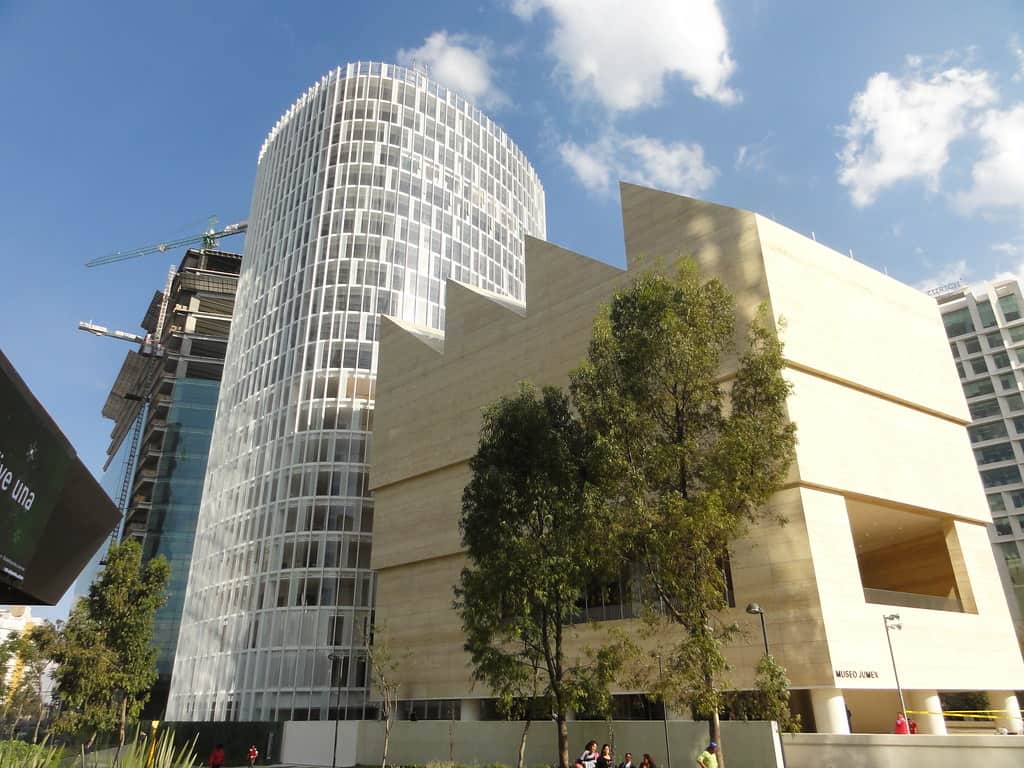
See a beautiful building that houses beautiful art.
Museo Jumex, which opened in the center of Polanco in 2013, is Mexico city’s newest museum filled with modern art.
The 15,000-square-foot white-concrete cube with a sawtooth top was built by British architect David Chipperfield and is sponsored by Grupo Jumex, one of Mexico’s major juice firms.
Andy Warhol, Cy Twombly, Martin Kippenberger, and Damien Hirst are among the artists in the Colección Jumex, one of Latin America’s greatest private modern art collections.
Paintings and drawings are used alongside light and video projects.
Non-permanent shows rotate frequently and usually only showcase one or two artists simultaneously. The art is displayed against clean white walls with just-right lighting in well-curated shows.
The structure appeals to both architecture and contemporary art enthusiasts.
Tours in Spanish are available at various times throughout the week; tours in English must be scheduled in advance.
The on-campus Great Café serves good coffee and simple appetizers like sandwiches and frozen yogurt.
Walk around Museo Jumex now and see the works of some of the most famed artists.
Address: Blvd. Miguel de Cervantes Saavedra 303, Granada, Miguel Hidalgo, 11520 Ciudad de México, CDMX, México
Museo Soumaya
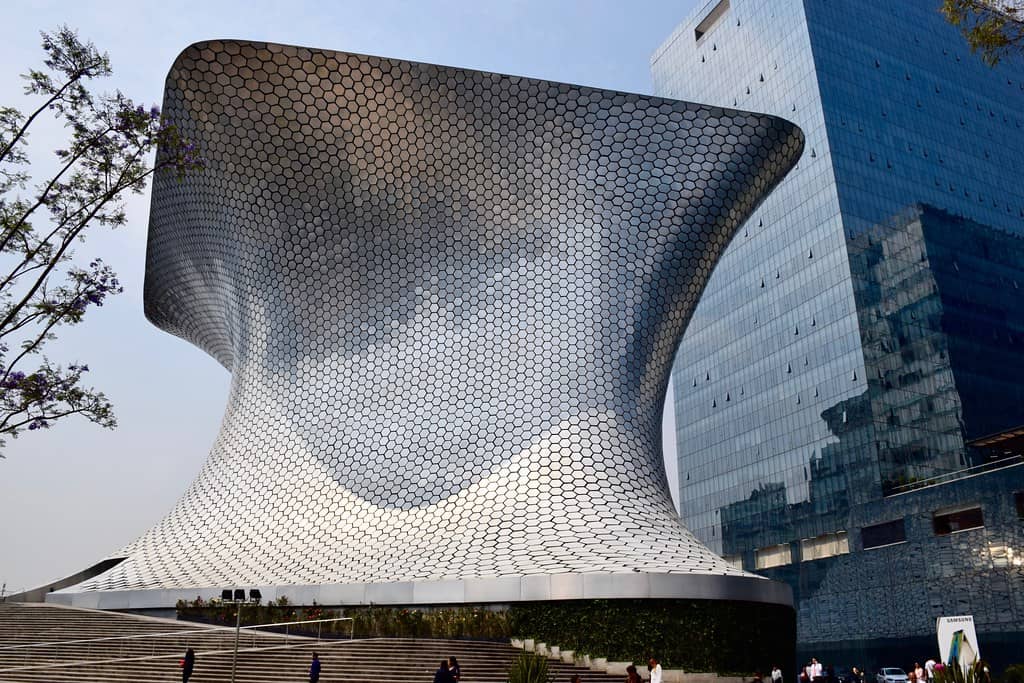
One of the world’s wealthiest men contributed 66,000 works of art.
The Soumaya Museum, which houses 66,000 pieces of mostly Central American and European art, was donated and built by Carlos Slim Hel, one of the world’s wealthiest men.
It spans 170,000 square feet and rises six stories above a plaza in northern Mexico City, towers over a plaza.
The gleaming ethereal tower, which opened in 2011, cost $70 million to construct yet resulted in a stylish complex of galleries accessible through a tiny front entry.
Gabriel Marquez is, a Colombian novelist, cut the ribbon when the opening happened, which was rather fitting given the museum’s fantastic aspect.
In fact, Marquez was the one who wrote “One Hundred Years of Solitude” and founded the “Magical Realist Literary Movement’.
The entire structure subtly benefits Mexico City’s cultural landscape while enriching the museum’s benefactor’s coffers.
Visit this jaw-dropping museum now when in Mexico City.
Address: 303 Blvd. Miguel de Cervantes Saavedra, Mexico City, 11529 Mexico
Museo Universitario Arte Contemporaneo
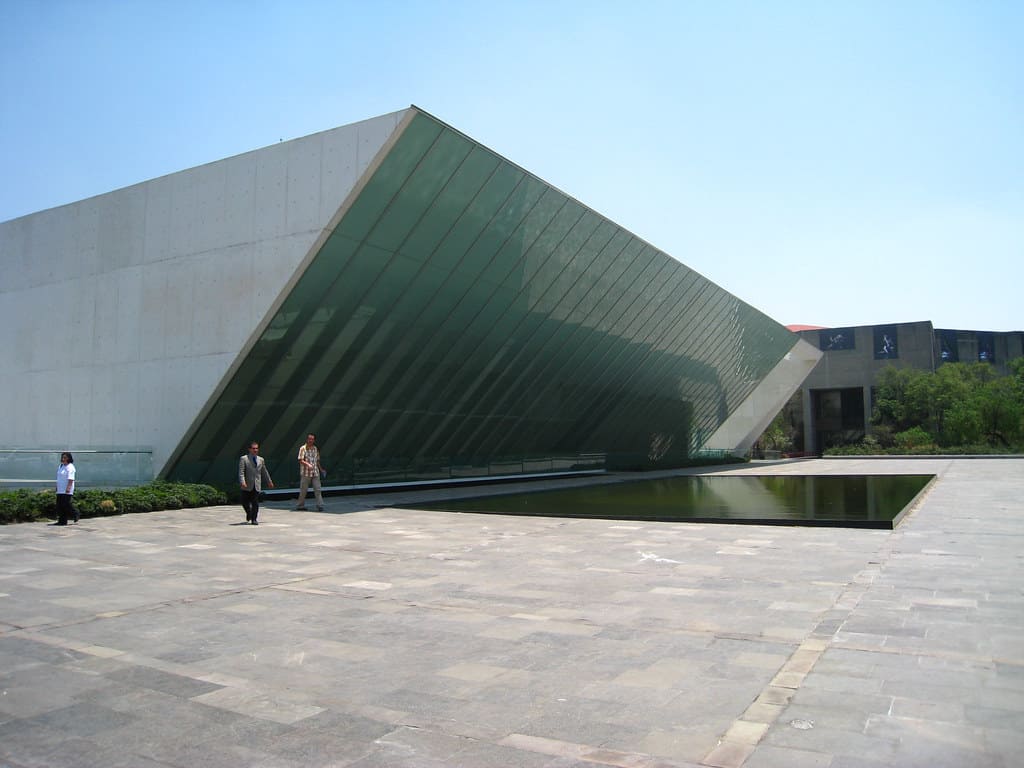
Teodoro Gonzalez de Leon designed this cutting-edge modern art museum, which features Mexican art from the 1950s.
On the premises of Mexico City’s largest public university, the MUAC is a 14,000-square-foot modern art museum. Architecture and design enthusiasts flock to the building designed by architect Teodoro Gonzalez de Leon.
The museum’s goal is to amass a collection of contemporary Mexican art from the 1950s onwards. Paintings, drawings, and video and sound installations are among the works.
The non-permanent exhibitions are what draw the most visitors to the MUAC. They have a wide selection of well-curated modern art in various mediums.
The university grounds (on an eco-reserve) are a popular weekend destination for families. Thus, the museum can be particularly busy on Saturdays and Wednesdays, and Sundays when admission is half-price.
The Nube Siete Café is surrounded by volcanic rock and offers glass-bottomed outside seats. It’s worth a look just for the design (but the food is also rather nice)
Visit this stunning museum now in Mexico City.
Address: Av. Insurgentes Sur 3000, C.U., Coyoacán, 04510 Ciudad de México, CDMX, Mexico
Palacio de Bellas Artes
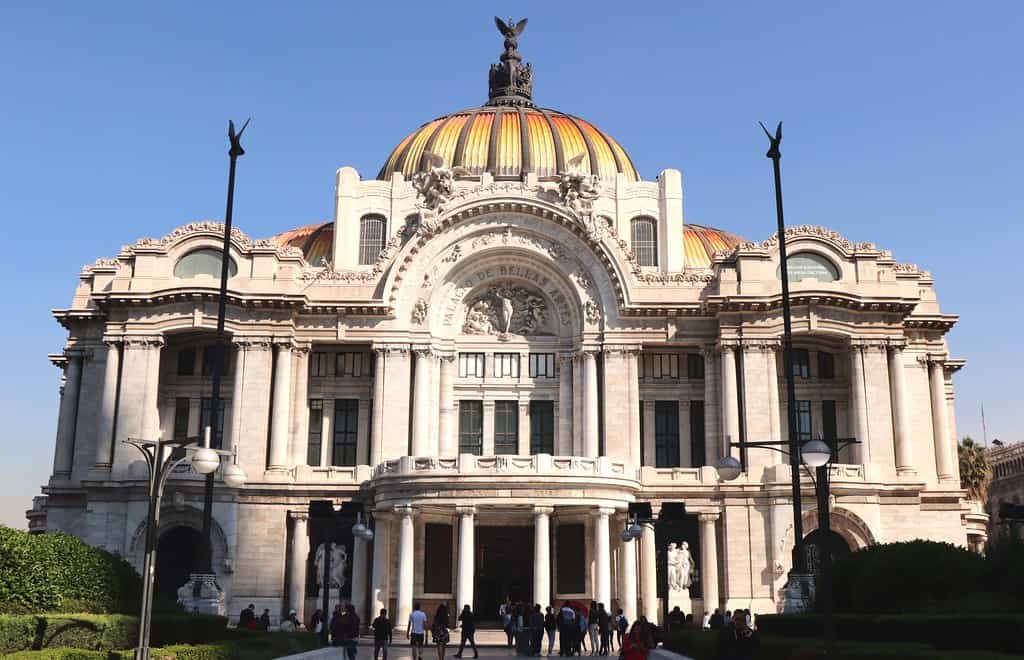
You have to marvel at this structure’s architectural grandeur!
Mexico City’s Palacio de Bellas Artes is one beautiful structure you will love seeing in person.
It got its grand architecture by the designs of Adamo Boari, an Italian architect.
He then incorporated neoclassical and natural world inspiration styles in his work.
As you tour further inside Palacio de Bellas Artes, you’ll find a unique blend of modern and classic art styles made by Federico Mariscal around the 1930s.
Moreover, the Palace of Fine Arts is a place full of artworks and murals of renowned artists.
In fact, Diego Rivera’s El hombre en el Cruce de Camino is exhibited on the west end of the building’s third level.
Also, on its fourth floor, The Museo Nacional de Arquitectura has displays on current architecture that are always evolving.
Overall, you will find a lot to do from its concert halls to the art center; Palacio de Bellas Artes is a must-visit place!
Visit this another one of Mexico City’s beautiful landmarks, and you will surely have a good time.
Address: Av. Juárez S/N, Centro Histórico de la Cdad. de México, Centro, Cuauhtémoc, 06050 Ciudad de México, Mexico
Palacio National
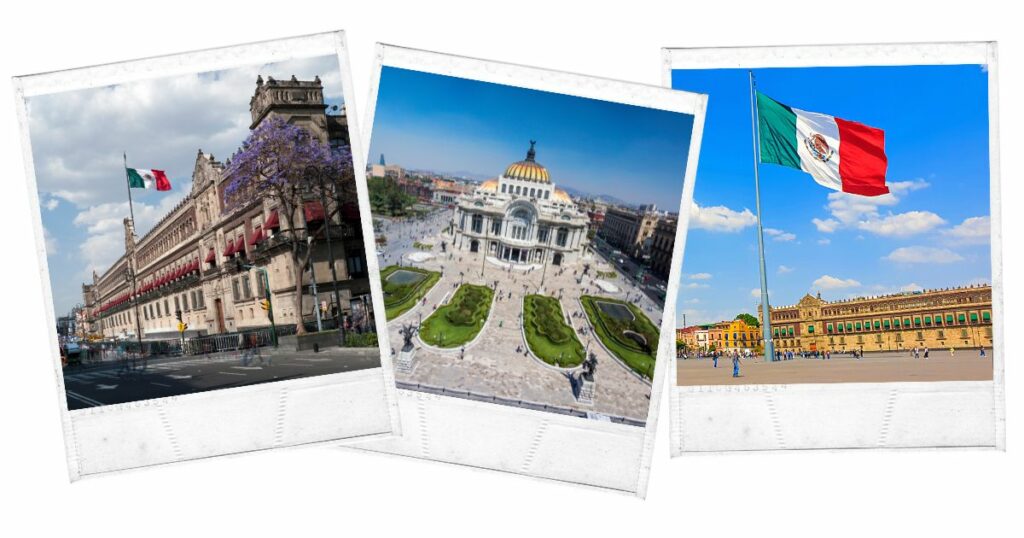
Visit the building that houses Mexico’s leaders.
The Palacio Nacional, or the National Palace, is the seat of the Mexican federal government.
At the same time, it houses the Federal Reserve and the White House.
As well as being the site of one of the country’s most important and well-known libraries, it also boasts beautiful paintings on it’s exterior.
In the early 16th century, Aztec ruler Moctezuma II built the first palace on this site.
The palace, along with most of the other Aztec constructions in the area, was destroyed by Spanish colonizer Hernán Cortés in 1521.
However, there are records of how magnificently furnished, and majestic the emperor’s residence was in the form of letters Cortés wrote back to the Spanish king.
Moreover, it used it to host the rulers of Nueva Espaa until Mexican independence in 1821.
Diego Rivera’s paintings show Mexican civilization from the advent of Quetzalcóatl to the post-revolutionary period inside this spectacular palace.
Altogether, there are nine murals on the first level above the patio, covering the north and east walls, depicting indigenous life before the Spanish invasion.
See beautiful architecture and stunning works of art here at the Palacio Nacional.
Address: P.za de la Constitución S/N, Centro Histórico de la Cdad. de México, Centro, Cuauhtémoc, 06066 Ciudad de México, CDMX, Mexico
Street Food Tours
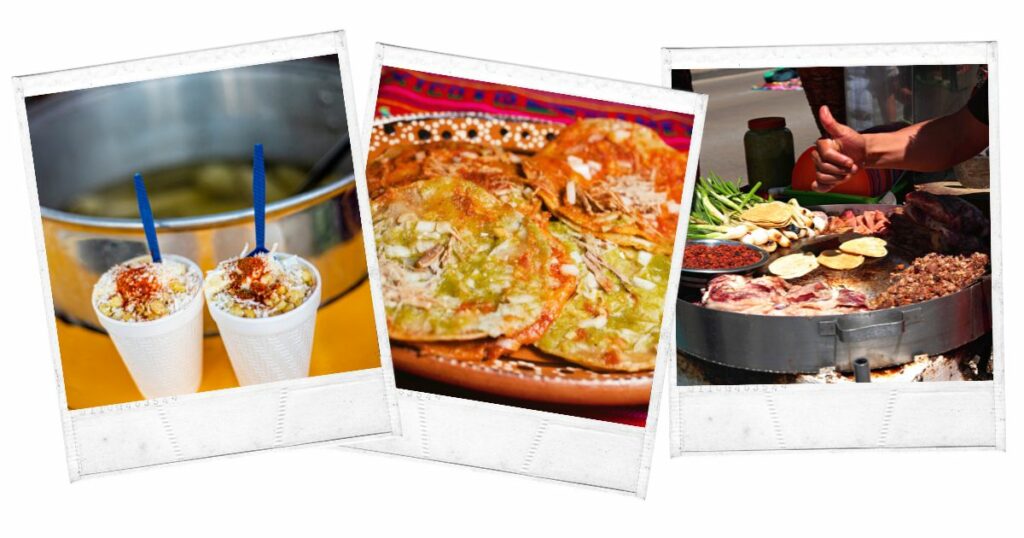
Taste the authentic Mexican flavors of the city’s thriving street food scene.
Nothing beats going with a local if you’re visiting Mexico City and want to learn more about the street food culture.
A knowledgeable guide can explain the food’s subtleties and the history of different recipes.
They’ll take you to hidden corners of the markets full of delectable treasures!
Eat Like a Local Tours is a female-owned food tour company in Mexico City that seeks to be one of the finest in sustainable tourism.
It offers fair compensation to its female-only employees and promotes female-owned enterprises in the marketplace.
In addition, a portion of the tour fee goes toward sending young girls to school to learn English.
Providing children with a well-rounded education will enable them to achieve and develop.
Any additional funds earned by the tour company are used to send some of the females on their own trips anywhere on the planet.
They enable travelers to see their city by allowing them to explore the same world of travel.
Also, even a portion of the tour fee is used to sustain the marketplaces’ infrastructure. Assisting in their improvement.
While eating in the marketplace is a terrific way to support local companies, supporting their work infrastructure is a sign of a truly sustainable tourism initiative.
There’s so much to eat in Mexico City, so visit now!
Address: Mexico City, Mexico
Templo Mayor
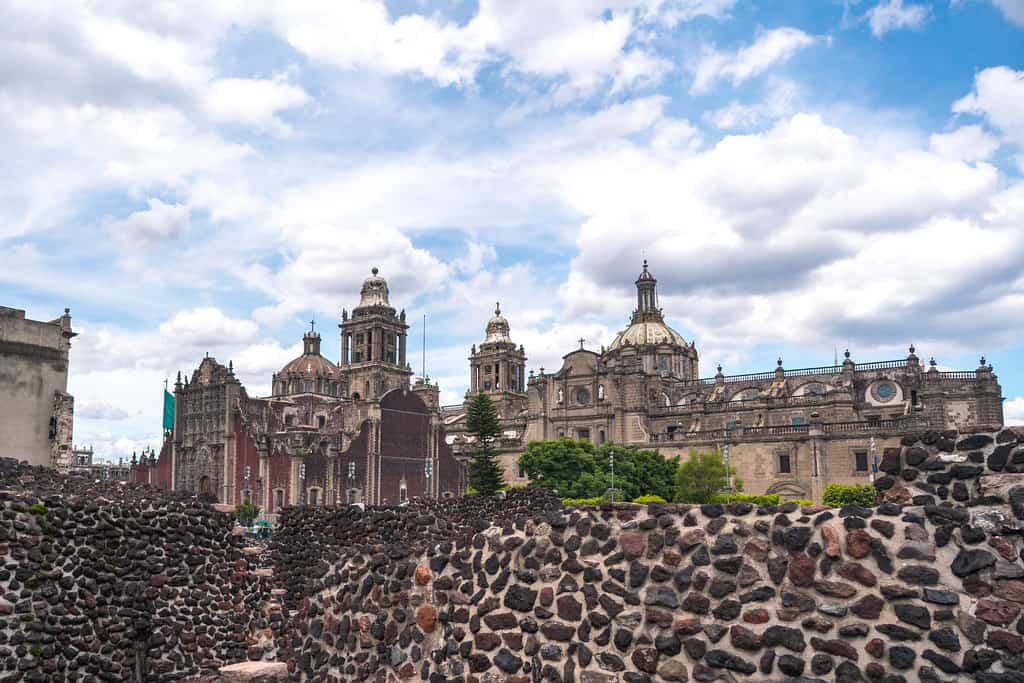
Uncover the Aztech myth behind this stunning location.
The Aztech myth claims that Huitzilopochtli, the deity of the sun, war, and human sacrifice, was born ready to fight his siblings from his mother Coatlicue’s womb.
This was because Coyolxauhqui, Coatlicue’s daughter, believed her brother had been duped and resolved to kill them both with the assistance of her 400 brothers.
Huitzilopochtli was born and beheaded his sister before hurling her body from a mountaintop.
In the night sky, the remains of his siblings (the stars) and Coyolxauhqui (the moon) still twinkle.
The government authorized 13 structures to be razed so that the Templo Mayor site could be investigated after discovering and recognizing that this could be the Aztec empire’s, Great Temple.
More discoveries have been made since then. The Aztec people’s main temple is now a museum and a UNESCO World Heritage site.
Templo Mayor also yielded a massive monolith of Tlaltecuhtli, the goddess who can give and eat life, in 2006.
The monolith has kept its original hues since the conquest of Tenochtitlán, in addition to its astounding size.
See this UNESCO world heritage site now and marvel at the wonder of the Aztecs.
Address: 34 República de Guatemala, Centro Mexico City, 06000 Mexico
Teotihuacan
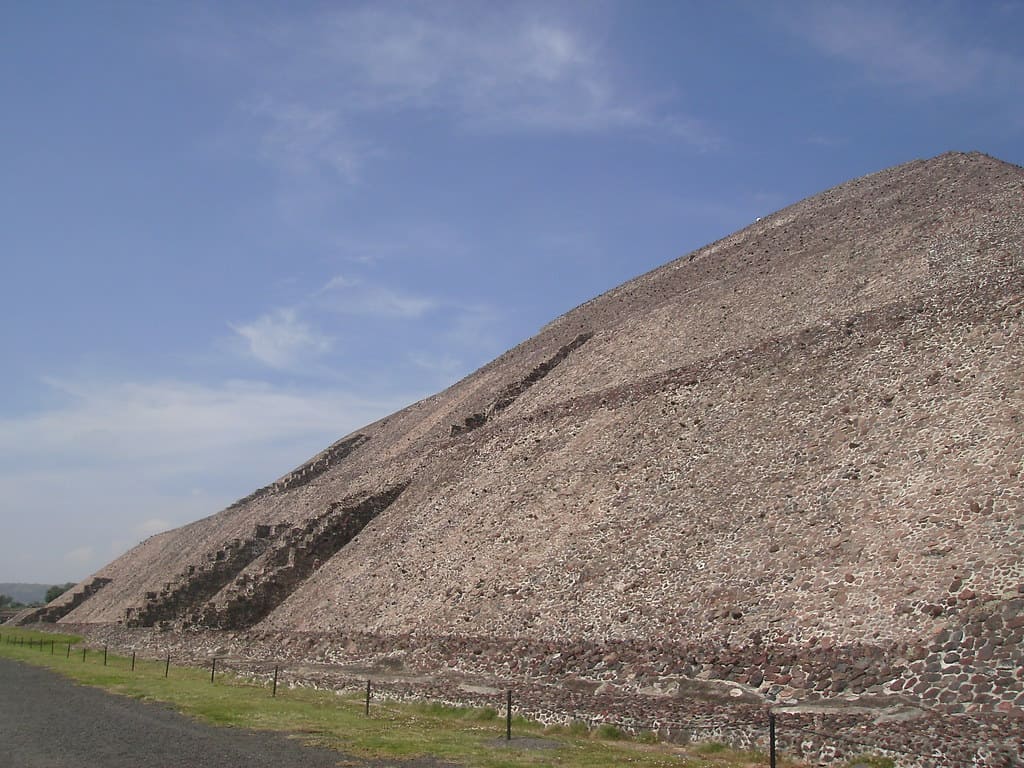
Take a day trip to this interesting ancient city.
If you just have time for a day trip from Mexico City, go to Teotihuacan and visit the incredible ancient ruins.
Teotihuacan, a UNESCO World Heritage Site, was one of pre-Hispanic Mesoamerica’s most prominent towns and cultural hubs.
During the first millennium A.D., it is thought that Around 125,000 people lived in the city, including multi-ethnic tribes like the Otomi, Zapotec, Maya, Mixtec, and Nahua.
The massive remains of the city, which date back approximately 2,000 years, have been remarkably well kept and are now one of the top things to do in Mexico.
Moreover, these massive pyramids, like the Temple of Quetzalcoatl and the Pyramids of the Moon and Sun, are the centerpiece (you can climb several).
Several trips will take you along the journey to the 16th-century Basilica de Guadalupe, one of the world’s most visited Catholic holy locations.
Leave early in the morning to arrive in the city by mid-day—and don’t forget to pack sunscreen!
This is a definite must-do when visiting Mexico City.
Address: Teotihuacan, Mexico
Trotsky Museum
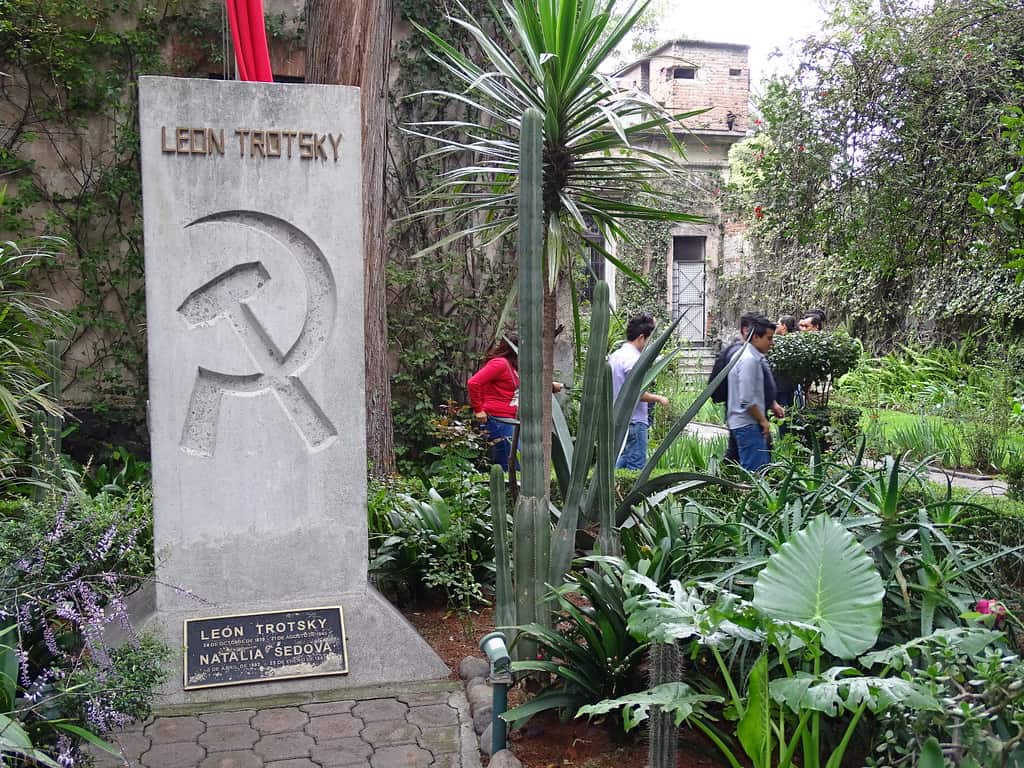
Come and explore this prominent artist’s home.
The revolutionary’s home, now a museum, is much as it was the day one of Stalin’s operatives, a Catalan named Ramón Mercader, apprehended him and smashed an ice ax into his skull.
Memorabilia and biographical notes are displayed in buildings off the patio.
Trotsky’s remains are interred in a mausoleum etched with a hammer and sickle.
Historically, Trotsky was exiled from the Soviet Union in 1929 and sentenced to death in absentia after finishing second to Stalin in the political fight. He sought asylum in Mexico in 1937.
Trotsky and his wife Natalia stayed in Frida Kahlo’s Blue House at first. Still, following a feud with Kahlo and Rivera, they relocated a few blocks northeast.
A failed assassination attempt is marked by bullet holes in the bedroom.
The entry is located behind the ancient house on Av Ro Churubusco. At the entry, inquire about free English-language guided tours.
Pay homage to this celebrated artist now by visiting his home.
Address: Av. Río Churubusco 410, Del Carmen, Coyoacán, 04100 Ciudad de México, CDMX, Mexico
Xochimilco
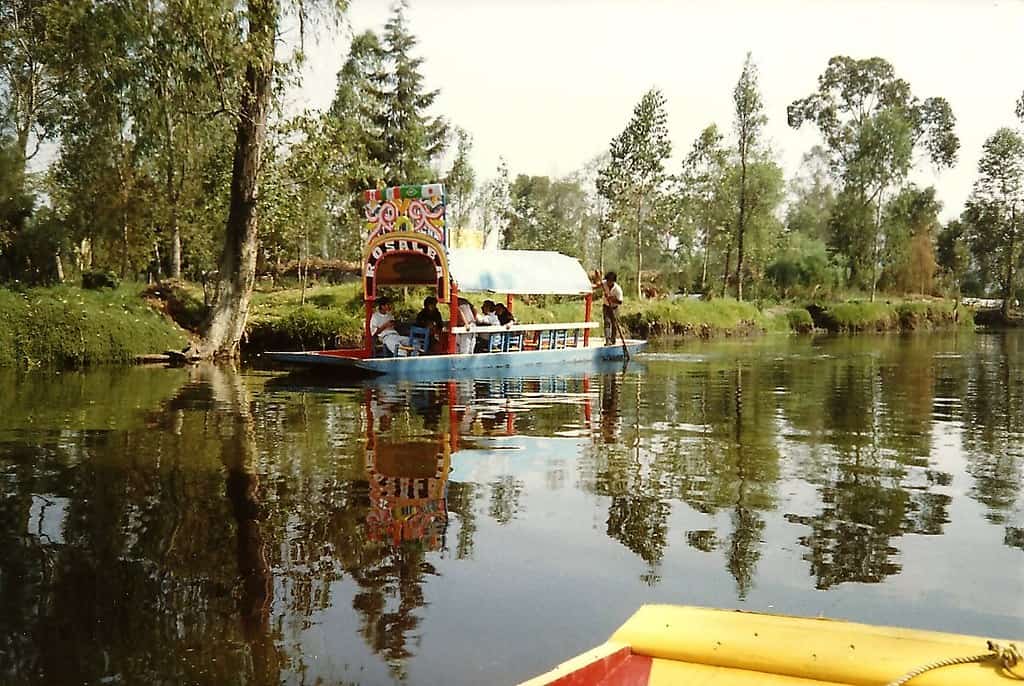
This location will appeal to anyone who likes getting intoxicated on colorful boats.
Xochimilco is a borough of Mexico City that is well known for its so-called Floating Gardens, which were designated a UNESCO World Heritage Site in 1987 and are about 45 minutes outside the city center.
It’s one of Mexico City’s most popular tourist attractions, with authentic trajinera boats gliding along canals.
Throughout the tour, you’ll see boats with mariachis, ‘ranchero’ trios, and marimbas, who will offer to play you a few songs to liven up your evening.
The Floating Gardens of Xochimilco, which were built atop an Aztec water transportation system, are essentially a river where you may ride colorful gondola-style boats for 2-3 hour cruises.
Inquire about a trip to the Island of Dolls, a creepy spot where dolls hang from the trees.
Julián Santana Barrera is supposed to have created the dolls to frighten away the soul of a girl who drowned near the location.
Although the views aren’t spectacular, it is a unique experience and an enjoyable social activity for tourists and residents.
Visit Xochimilco now for a fantastic time in Mexico.
Address: Xochimilco, Mexico City, Mexico
Zocalo
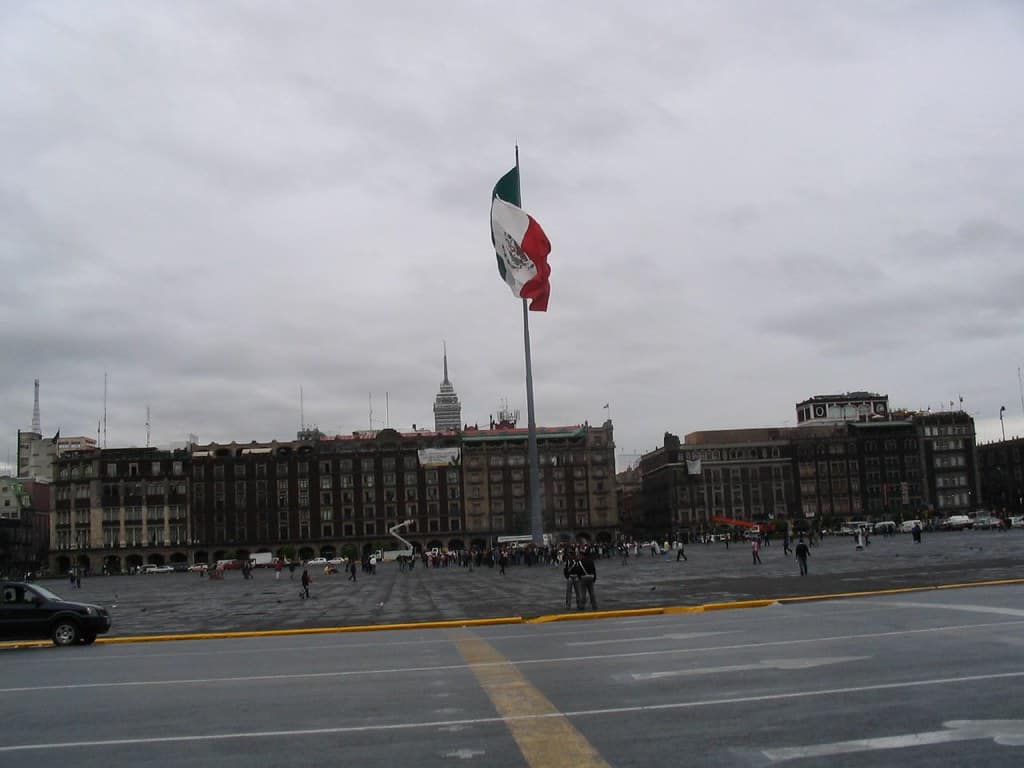
Wander around the heart of Mexico City.
The Plaza de la Constitución is the hub of Mexico City. When plans for a glorious monument to freedom fell through, leaving only the pedestal, residents began calling it the Zócalo, which means ‘base.’
It is one of the world’s largest city squares, measuring 220 meters north to south and 240 meters east to west.
The Teocalli, Tenochtitlán’s ceremonial center, was immediately northeast of the Zócalo. The powers that be now call the Zócalo home.
The Palacio Nacional is on the east side, the Catedral Metropolitana is on the north, and the city government buildings are on the south.
On the plaza’s west side, the Portal de Mercaderes arcade is lined with jewelry stores and opulent hotels.
The Danzantes Aztecas shout in Náhuatl and dance daily in the square, donning snakeskin loincloths and shell ankle bracelets. Drummers play the huehuetl (indigenous drum).
Although there is no documentation of the actual dance motions, it is designed to imitate the Aztec mitote, a frenetic ceremony performed by pre-conquest Mexicans during harvest seasons.
There are lots to see and do in Zocalo, don’t forget to visit when in Mexico City.
You haven’t made up your mind to go to Mexico City, Mexico, yet, have you? Click here for why visit Mexico City, Mexico, at least once in your lifetime here.
Address: P.za de la ConstituciónCentro Histórico de la Cdad. de México, Centro, Ciudad de México, CDMX, Mexico

